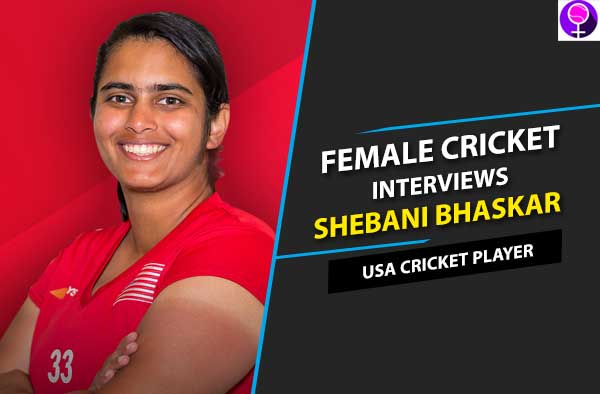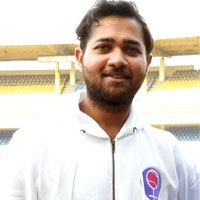
1. What was your first interaction with cricket like? What age did you start playing cricket?
I started playing competitive cricket at the age of 11. Before that, we played cricket at home, on the beach, under stairs on the side of the house, just as we played other sports as a family.
2. You were born and raised in USA. How was cricket back then in USA?
I was born in the US. But I was not raised in the US. I grew up in different countries, moving around every few years.
3. Sports runs in your family with your sister Meenakshi being a national level rower. Did that influence your sports career?
Yes, it does influence and inspire me.At home, we’ve grown up playing various sports from a young age in school, college, and clubs.
4. Which other sport did you play during your school/college days? What made you stick to cricket?
I did athletics, swimming, played soccer, basketball, volleyball, and a few others. I also play golf. Opportunities presented themselves in cricket, and things just happened.
5. What was the general perception about cricket in the soccer-rugby-basketball freak country? Has it evolved over the years?
Majority of my time has been in India where cricket is a religion.
6. What happened in 2008 when your family moved back to Chennai? Tell us about your stint at VB Chandrashekhar’s academy, ironically you were the first girl to be given admission there?
My father has seen VB Sir play and thought he is the best batting coach in Chennai. He believed that if somehow he could get me to be coached by VB Sir, I would become an international cricketer. It turned out better than my father imagined.
My father’s transfer to Chennai in 2008 was a blessing in disguise. The senior cricketers and coaches in Tamil Nadu gave me good development opportunities while playing for Tamil Nadu under-19 and under-16 teams to be a part of the senior Tamil Nadu women’s squad. At just 14 years of age, carrying drinks and learning from seasoned senior cricketers in the team from close range gave a tremendous boost to my cricket. By age 16, I was playing for the South Zone Senior Women’s team in India.
7. When and how did you come to know about your selection in the USA national team? Did you see that coming? What age did you make your national debut?
I made my national debut at the age of 17 at the ICC Women’s World Cup Qualifier in Bangladesh in 2011. A few months before that, the team was announced.
8. You have established yourself as a complete all-rounder in the team. But given a chance to pick only one from batting, bowling and fielding, what would that be?
Cricket is a batsman’s game. I should probably say batting.
9. There are players from the Caribbean, India & Pakistan in the USA Team. How easy / difficult was it to mingle with players from such diverse backgrounds?
Diversity is one of our strengths. Each player brings a different dynamic to the team. Since I have played in different countries, Australia, India, New Zealand, Bangladesh, USA, and have moved around and lived in different countries, mingling with players comes naturally to me.
10. Tell us about your experience at the 2011 World Cup Qualifiers in Bangladesh. How was the feeling being awarded with the Player of the match trophy at a very young age?
It was a happy and proud moment. To throw down the stumps to win the match by one run, was an amazing feeling.It was a culmination of years of playing and practicing. I was happy I could contribute to the team, and it is always special when you are on the winning side.
It was an interesting experience to play against so many different countries in the space of two weeks. Sri Lanka played with a predominantly spin based attack, South Africa with a pace attack. Captain Doris Francis deserves special praise. You mature as a player after you play international cricket. It is a different class of competition.
11. USA was deprived of formal cricket for almost 5 years, but still has managed to make its mark in the international circuit. What do you think makes this team so strong?
Players are skilled. Players who have played for the West Indies, in India, etc. and who have acumen for the game of cricket makes the team strong.
12. What do you feel is an area to work and improve on at a personal level?
The game is constantly evolving, and we must evolve with it. My cricket foundation has been as a boundary-hitter which is very suitable for the one-day format. For the T20 format, I need to work on sixer hitting.
13. Talk about the coaches / mentors under whose guidance has your cricket evolved?
Over the last 12 years, so many people have played important roles in shaping my cricket.
14. Tell us more about the current coaching, support and administrative staff at USA Cricket?
Other teams have a batting, bowling, fielding, and head coach. For us, it is Coach Anand Tummala who does everything for the US women’s team. He is a former Delhi all-rounder. With a strong knowledge bank about the game, he has helped the US team record its first victories in Australia earlier this year. USA Cricket has been extremely active in creating opportunities for women cricketers. In the last six months, they have created opportunities for us to play in the Caribbean, to play in the ICC Qualifiers in Scotland, a development tour of Australia, and with various Combines spread across the States.
15. Throw some light on the current domestic structure in USA? Are there any annual camps/tournaments to churn out quality female players?
There are many coaches and organizations especially the West Coast, East Coast, Texas, Chicago, etc. who are devoting their time to helping girls who are interested in cricket in the US. CanAm, for example, is an organization that brings girls and women from various parts of the Americas, including the US, Canada, Argentina, Brazil, to play more. They organized a tour of England last year, they also fielded a team in the International Cricket Festival in Philadelphia last year. There’s an annual tournament held in Atlanta by the Georgia Women’s Cricket Association. There is the Roy Sweeney Memorial Tournament held in New York. USA Cricket is conducting Combines across the country to encourage cricketers, male and female.
16. How popular is cricket at school/college level in USA? Do you think introducing sport at that level will help USA cricket?
Not having studied school or college in the US, I might not be the right person to answer this.
17. Only 23 and you have been given the honor to captain USA women’s cricket team. How is the feeling? When did you learn about this new role coming to you?
Ahead of the development tour of Australia earlier this year, I was told I would be leading the side. It is a great honor to lead the national team. Having captained the Tamil Nadu state under-16 and under-19 girls’ teams, and my college and university in Chennai for five years, had prepared me for this privilege.
18. What is the pathway / stages to get into the national team of USA?
If by pathway you mean a pathway for a youngster to make it to the national level, it is the same as any sport. Step 1 is to find a good coach, so you learn the basics right. Step 2 is to work hard so you raise your game to the international level. If you mean the selection procedure, it is quite straightforward. You have to participate in the Combines organized by USA Cricket, and outperform the regulars in the team in order to get in.
19. Is cricket a sustainable profession in USA? Or there’s something else players need to do for a living?
As of now, cricket in the US is a purely amateur sport. There are no contracts from the cricket board for women players. Everyone has a job in their line of work and come together for matches.
20. When did the preparation for ICC World T20 2020 start? How has it been so far?
The preparation for the World T20 started with the development tour of Australia in March-April 2018. It has been a terrific start and more such initiatives are in the pipeline leading up to 2020.

On a mission to promote women’s cricket around the world! Follow our story: